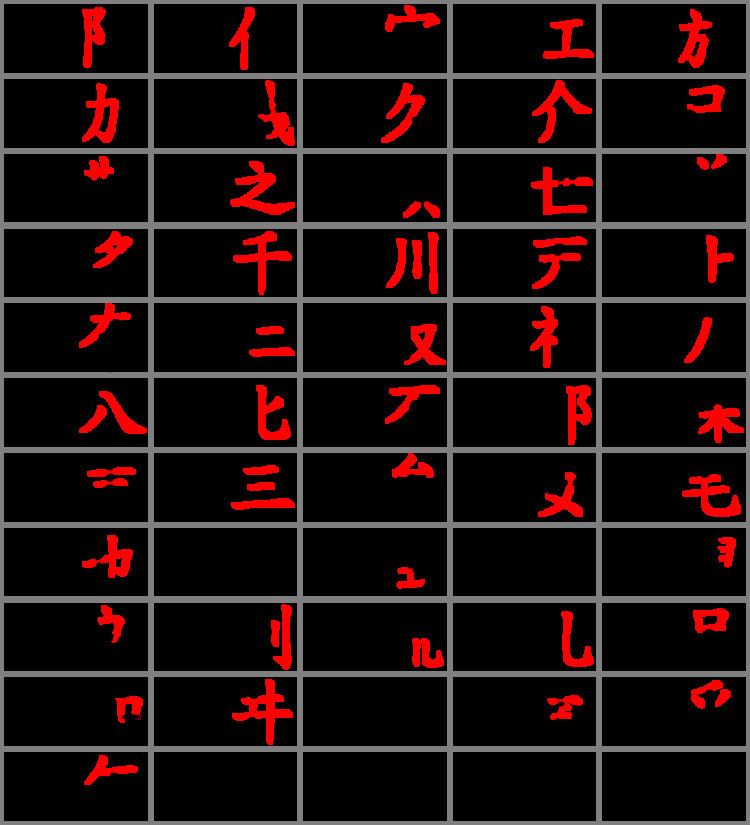Time period c. 650 CE to Meiji era | Child systems Hiragana, katakana | |
 | ||
Parent systems Oracle Bone ScriptSeal ScriptClerical ScriptRegular scriptMan'yōgana万葉仮名 | ||
Man'yōgana (万葉仮名) is an ancient writing system that employs Chinese characters to represent the Japanese language and was the first known kana system to be developed as a means to represent the Japanese language phonetically. The date of the earliest usage of this type of kana is not clear, but it was in use since at least the mid seventh century. The name "man'yōgana" is from the Man'yōshū, a Japanese poetry anthology from the Nara period written in man'yōgana.
Contents
Origin
A possible oldest example of Man'yōgana is the iron Inariyama Sword that was excavated at the Inariyama Kofun in 1968. In 1978, X-ray analysis revealed a gold-inlaid inscription consisting of at least 115 Chinese characters and this text, written in Chinese, included Japanese personal names which were supposedly phonetically written. This sword is thought to have been made in the year 辛亥年 (471 A.D. in commonly accepted theory). There is a possibility that the inscription of the Inariyama sword may be written in a version of the Chinese language used in the Korean-peninsula kingdom of Baekje.
Principles
Man'yōgana uses kanji characters for their phonetic rather than semantic qualities—in other words, they are used for their sounds and not their meanings. There was no standard system for choice of kanji; different kanji could represent a similar sound, the choice made on the whims of the writer. By the end of the 8th century, 970 kanji were in use to represent the 90 morae of Japanese, far more than what was needed. For example, the Man'yōshū poem 17/4025 was written as follows:
The sounds mo (母, 毛) and shi (之, 思) are written with multiple characters. While all particles and most words are represented phonetically (多太 tada, 安佐 asa), the words umi (海) and funekaji (船梶) are rendered semantically.
In some cases, specific syllables in particular words are consistently represented by specific characters. This usage is known as Jōdai Tokushu Kanazukai. It has led historical linguists to conclude that certain sounds in Old Japanese, represented by differing sets of man'yōgana characters, may have merged since then.
Types
In man'yōgana, kanji are mapped to sounds in a number of different ways, some of which were straightforward and others which are less so.
Shakuon kana (借音仮名) are based on Sino-Japanese on'yomi reading, in which one character represents either one mora or two morae.
Shakkun kana (借訓仮名) are based on native kun'yomi reading, one to three characters represent one to three morae.
Development
Due to the major differences between the Japanese language (which was polysyllabic) and the Chinese language (which was monosyllabic) from which kanji came, man'yōgana proved to be very cumbersome to read and write. As stated earlier, since kanji has two different sets of pronunciation, one based on Sino-Japanese pronunciation and the other on native Japanese pronunciation, it was difficult to determine whether or not a certain character was either used to represent its pronunciation or its meaning, whether it was man'yōgana or actual kanji, or both. On top of that, Buddhist monks found recording oral teachings time-consuming since every syllable would be written using an entire kanji, which might have up to 23 strokes even if one considers only the most common Kanji.
To alleviate the confusion and to save time writing, kanji that were used as man'yōgana eventually gave rise to hiragana and katakana. Hiragana was developed from man'yōgana written in the highly cursive sōsho style by women; katakana is based upon man'yōgana, and was developed by Buddhist monks as a form of shorthand. In some cases, one man'yōgana character for a given syllable gave rise to the current hiragana equivalent, and a different one gave rise to the current katakana equivalent. For example, the hiragana る (ru) is derived from the man'yōgana 留, the katakana ル (ru) is derived from the man'yōgana 流.
The use of multiple kanji for a single syllable also led to hentaigana (変体仮名), alternate letterforms for hiragana. Hentaigana were officially made obsolete in 1900.
Man'yōgana continues to appear in some regional names of present-day Japan, especially in Kyūshū. A phenomenon similar to man'yōgana, called ateji (当て字), still occurs, where words (including loanwords) are spelled out using kanji for their phonetic value. Examples include 倶楽部 (kurabu, club), 仏蘭西 (Furansu, France), 阿弗利加 (Afurika, Africa) and 亜米利加 (Amerika, America).
